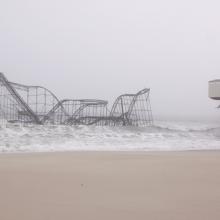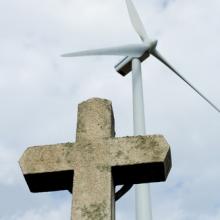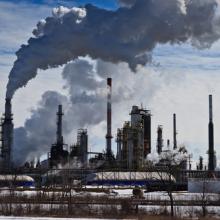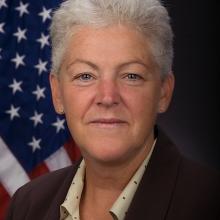Environment
“WE WANT FARMERS to rediscover the sacredness of farming,” says Rev. Daniel Premkumar. Premkumar’s respect for farmers and farming grew from his experience of serving for nearly 40 years as a Lutheran parish priest in Andhra Pradesh, the “rice bowl” of India. “We have forgotten that the people who grow our food play a critical role in the care of creation,” he says. “That is why we are creating a farmers’ Bible.”
We sat in his office at the Synod of the Church of South India, the largest Protestant church in the country, in Chennai. The church includes 10,000 Protestant congregations (Presbyterian, Congregational, Reformed, Anglican, and Methodist) across South India. Rev. Premkumar is now director of diaconal concerns for the church, and he is advancing the concept of agri-ministry, which views agriculture as a form of ministry and upholds the need for church ministry to directly address the concerns of farmers. He created the Agricultural Workers Fellowship (AWF) in 2011. A small AWF workshop where theologians and farmers came together to discuss agricultural perspectives on biblical passages led to the idea of a book offering a reading of the Bible from the farmers’ perspective. They hope this book and a farm workers’ devotional guide will be finished by 2014.
The initiative to spur the church to explicitly integrate faith and agriculture comes at a time when food and farming in India—and globally—is at a critical juncture. Will India follow the United States in relying on genetically modified crops, monoculture, inorganic and unsustainable farming practices, and the corporatization of agriculture? Or will it restore farming as a livelihood, emphasizing safe food and healthy soil and water?
This week marks the one-year anniversary of Hurricane Sandy, the superstorm that decimated metropolitan areas of the East Coast last fall.
Damage from the storm resulted in more than 100 fatalities, with an estimated loss of $65 billion. Thousands of homes were lost, and millions were without power for days. Thousands of flights were canceled along the eastern seaboard, and multiple public transit services were suspended, including Amtrak and New York City’s bus and subway system. Even the U.S. economic structure ground to a halt, with NASDAQ and the New York Stock Exchange closing to buckle down before the deluge.
One year later, we reflect on reconstruction efforts post-Sandy. We also pause to assess the role of climate change, exacerbated by human actions, in the creation and severity of the storm.
Unprecedented levels of air pollution effectively closed the city of Harbin in northern China earlier this week. Smog limited visibility in some places up to 30 feet, and measurements of fine particulate pollution skyrocketed a record 40 times higher than the worse safe level set by the World Health Organization, according to the Washington Post.
In the city of 11 million, schools, public bus routes, and the airport were all forced to suspend activities given the unsafe conditions. Hospital admittances of patients with respiratory problems soared an additional 30 percent.
The cause, according to local Chinese news outlets, was the first day of the city’s heating being turned on before winter. China’s air quality has consistently been found to be harmful in the recent decades of the country’s rapid industrial development.
Last week I found out about the unfolding cases of sexual harassment by a respected science blogger and the head of Scientific American’s blog, Bora Zivkovic. It shocked me because I’ve met the man, though I don’t know him well. And so I read the accounts of the three women science bloggers who exposed him. Thefirst one shocked me and made me angry. And the second one shocked me further, because she wrote of the harassment continuing at a conference I attended. It happened right under my nose.
Women are an important part of the science community, but there’s a group of powerful men who are gatekeepers, and some of them use this power as a tool to be overtly sexual with female bloggers looking to advance their writing careers in the science community. The allegations regarding Bora Zivkovic seem to be hard for many in the science community to swallow because he has been a vocal supporter of women’s importance in the field and has actively nurtured the careers of many bloggers.
There’s a debate happening on The Christian Post, and we’re hearing more and more evangelical voices expressing concern over climate change.
Over the summer, talk radio pundit Rush Limbaugh made a comment about people believing in God and manmade global warming: he said it was “intellectually impossible.” It is not, of course, impossible to have faith in God and to agree with 97 percent of scientists that we are harming God’s creation with climate change. And in response to Rush’s comments, Sojourners sent Mr. Limbaugh a letter signed by more than 9,000 people of faith asking him to correct the record (which he has not yet done).
But Rush Limbaugh’s comments also sparked a conversation on the popular evangelical website, The Christian Post. Two prominent climate scientists who are also evangelical Christians, Dr. Katharine Hayhoe and Dr. Tom Ackerman, responded to Rush in an open letter on site. They told Rush that, contrary to his assumptions, they are compelled to work in their field by both their faith in God and their expertise in atmospheric science.
Occurrences of oil spills in several states have garnered little media attention in the last few years. In some cases, prompt reports are recorded, yet in others, days have gone by before the authorities are alerted and the spill becomes public knowledge.
The most recent episode happened Oct. 15, in Port of Long Beach, Calif. Upon discovery of an oil leak, Exxon Mobil announced that it was temporarily suspending operations of its pipeline system. The pipeline, which connects to the company’s refinery in Torrance, carries up to 155,000 barrels of oil per day. Exxon filed documents with the California Emergency Management Agency that claimed the leak did not affect waterways, although the company was ordered to pay a $236 million fine for contaminating groundwater in New Hampshire this past April.
Another spill was initially discovered on Sept. 29 by North Dakota farmer Steve Jensen, the Associated Press reported. While harvesting wheat, Jensen discovered the leak in his field “spewing and bubbling 6 inches high.” The rupture was a break in Tesoro Corporation’s underground pipeline. While it remains unconfirmed, early evidence cites that corrosion on the 20-year-old pipeline is the cause of rupture. At least 20,600 barrels of oil flooded the 7-acre spill zone, equal to about 7 football fields.
The delay in making public North Dakota’s oil spill proves as worrisome as the spill itself. It took 11 days after the spill’s discovery for it to become public knowledge. Officials claim they were not aware how extensive the spill was, but critics point to the state’s financial benefits in the recent gas and oil boom as reason for the authorities’ hesitancy in coming down on oil companies. But economic incentives shouldn’t diminish the serious need to weigh environmental risks and costs.
The cases begin to pile up.
I just completed my first Climate Ride, journeying 300 miles by bicycle over five days with 200 other climate activists. Climate Ride began five years ago, and the riders raise money for organizations that work on sustainability and climate change. They’re also a way to spread the word about the growing and increasingly determined climate movement. For those of us who take part – by now, thousands of us have – the rides have a deep and lasting impact.
These are my reflections from the last day of the ride; you can read reflections on the first four days of the Climate Ride here.
I always thought of climate change as something that affected developing countries. Through my work at World Renew, an international disaster response and community development organization, I am well acquainted with the devastating effects of changing growing seasons in Africa and environmental refugees in Bangladesh. I probably shouldn’t have been so surprised to learn that there are ecojustice issues here in the U.S. — but I was.
Last week I had the opportunity to tour the town of Jean Lafitte just outside New Orleans. Hosted by Sojourners, it was one of the “Go and See” options during the Christian Community Development Association conference.
Our tour began with a presentation by the Rev. Kristina Peterson and Mayor Tim Kerner at the Jean Lafitte National Historical Park and Preserve. There we learned that since the 1930s, Louisiana has lost a football field of wetlands every 38 minutes. At the current rate, the state will lose an area of wetlands the size of Rhode Island by 2050. According to Peterson, 36 percent of the wetland loss can be attributed to the activities of the oil and gas industry — in particular, the canals they carve out.
This Wednesday on Capitol Hill, the House subcommittee on Energy and Power held a hearing to discuss the Obama administration’s climate change policies and activities. The policies in question were the president’s Climate Action Plan, announced this summer, which has three main pillars:
- cutting carbon emissions,
- leading international efforts to combat climate change, and
- preparing the United States for climate change impacts.
The Environmental Protection Agency Administrator Gina McCarthy and the Energy Secretary Ernest Moniz were present to answer questions about the president’s plan, which works with new and existing programs in both agencies to reduce our climate change pollution and increase our resilience to climate change. Some of the programs are required by a recent Supreme Court decision that labeled carbon dioxide a pollutant; others, as Moniz pointed out, would happen to carry the benefit of energy efficiency.
For some members of Congress, this is a problem because they do not wish to cede any ground to the executive. For others, it is a problem simply because they do not wish to do anything about climate change.
David vs. Goliath: Residents in a Colorado city are fighting their local coal monopoly for the chance to move their city to clean energy. The coal company has more money – a LOT more money – but the organizers have more heart. This short 6-minute video is well worth watching.
40,000 jobs sound pretty good: According to the new 2013 second quarter clean energy report form Environmental Entrepreneurs (E2), clean energy and sustainable transportation projects launched this year created close to 40,000 green jobs in the U.S.
I love Netflix. I love that from the comfort of my couch, I can watch almost an endless selection of movies and TV shows. I’m re-watching all of The West Wing right now, along with most of Washington and probably much of the country. My friend Kat told me recently that she and her fiancé are watching it for the fifth time on Netflix, despite it sitting in a deluxe DVD set above their TV. Why get up to switch DVDs when your streaming player automatically starts the next episode for you?
So I wasn’t too happy when I read that my Netflix habit is seriously energy intensive. In a new article on Salon.com, I learned that watching Netflix streaming for an hour a week uses more energy each year than two new refrigerators. In my household we definitely watch a lot more than an hour a week.
Fred Bahnson’s first bit of advice when he started planning a church garden eight years ago came from an elderly tobacco farmer who grabbed a handful of soil, rolled it around in his fingers and shook his head:
“You don wohn fahm heah,” he said in his deep North Carolina drawl.
Those were not the only discouraging words he received as he planted and cultivated one of the earliest and most successful church gardens, 20 miles north of Chapel Hill.
But Bahnson, a Duke Divinity School graduate and a pioneer in the church gardening movement, had a different view of farming than the older tobacco farmer. He knew that if he gave back to the soil more than he took out — in the form of compost, manure and other soil food — he could create an abundant garden.
In his letter to the Romans, the apostle Paul writes: “I consider that the sufferings of this present time are not worth comparing with the glory about to be revealed to us. For the creation waits with eager longing for the revealing of the children of God …” (Romans 8:18-19)
And who are God’s children in the immediate context? Paul explains the “children of God” are those whose spirits cry “father” when referring to God. “For,” according to Paul, “all who are led by the Spirit of God are children of God.” (Romans 8:14) If this is true, then why is creation longing for the children of God (those led by God’s Spirit) to be revealed?
In Genesis 1, the author writes, “God saw everything that he had made, and indeed, it was very good.” The Hebrew words for “very good” are mehode tobe. Mehode means “forcefully” and in the Hebrew context tobedoes not necessarily refer to the object itself. Rather it refers to the ties between things. So, when God looked around at the end of the sixth day and said, “This is very good,” God was saying the relationships between all parts of creation were “forcefully good.” The relationship between humanity and God, men and women, within families, between us and the systems that govern us, and the relationship between humanity and the rest of creation — the land, the sea, and sky and all the animals and vegetation God created to dwell in those domains—all of these relationships were forcefully good!
“But you, keep your head in all situations, endure hardship, do the work of an evangelist, discharge all the duties of your ministry.” 2 Timothy 4:5 (NIV)
On Oct. 28, I was shocked into a cruel reality when I received an urgent text message as I was about to preach my Sunday sermon at Mount Carmel Baptist Church in Arverne (Far Rockaway), N.Y. We were told to evacuate immediately, and that both of the bridges that lead to and from the western portion of the peninsula would be shut down. Hurricane Irene had proven to be a false alarm in 2011, and we mistakenly thought that Sandy would be as well. I instructed all of our parishioners to leave immediately after service. My family and I packed up and headed out to my sister’s place in Bloomfield, N.J.
When I ventured back on Halloween, it took more than five hours to get to Far Rockaway, a peninsula that lies between Jamaica Bay and the Atlantic Ocean. What I saw on the way was sobering, if not devastating: boats in the middle of the street, debris everywhere, no electricity for miles and miles of Queens and Long Island, and homes – hundreds, if not thousands flooded — many destroyed. My own home and church in Arverne took on nearly 7 ft. of water. At Mount Carmel, our offices, fellowship hall, kitchen, and bathrooms were destroyed.
Forget about future generations – climate change is already hitting poor people around the world, not to mention contributing to natural disasters in the U.S. from New York City to Arizona. Apparently that’s not enough for some members of Congress, who have chosen to use their authority to try to block any and all attempts to do something about the problem.
Earlier this month, President Barack Obama announced a major, comprehensive plan of action on climate change – changes that would do much to protect human health, the poor, and future generations by mitigating some of the worst impacts of climate change. A central part of the plan is to address climate pollution at its largest source: coal-fired power plants.
Unfortunately, many members of Congress are already taking steps to decry the president’s plan as a “war” – on coal, on American energy, and yes, even on America itself. Leaders from John Boehner to Michele Bachmann to Joe Manchin have made it pretty clear that they view attempts to care for creation as an assault on our country.
In an attempt to rebuild the image of the five gulf states — Alabama, Florida, Louisiana, Mississippi, and Texas, federal and state officials have joined forces on their journey to replenish the damage from 2010's BP oil-well tragedy. Talks of baseball stadiums, sea walls, and donations to the Gulf Coast Ecosystem Restoration Council are among the many entities who will benefit from President Obama’s Restore Act signed last year. The New York Times reports:
The money will mostly be split among the states and a new entity, the Gulf Coast Ecosystem Restoration Council, composed of state and federal officials. There are already plenty of ideas among the states for spending the cash, including constructing a sea wall around the city jail in Mobile, Ala., and deepening shipping channels. Biloxi, Miss., is using money already given to the state by BP to build a baseball stadium.
Here’s another idea: the states and the council should require that a nickel of every dollar they control be used to buy and protect coastal marshes and wetlands. It is the most important thing they can do to help the gulf survive the next oil spill.
Read more here.
I’ve believed that climate change is the greatest moral issue facing us, and something I want to work on in my congregation. But how? I asked someone who had conducted a survey in our denomination, and he said that most churches discussed the issue but had little or no concrete action. I talked to activist congregations whose members were experiencing burnout and no longer meeting as a group. In a meeting with concerned congregations, I found that they experienced a big separation between climate-change interest groups and social action groups. In my congregation, we formed a “Green Team” that was concerned with saving energy, but it was reluctant to do any political action.
After much prayer and many conversations and group meetings, our Social Justice Minister called a group together that he called “The Climate Change Initiative.” Twenty-five of us showed up, and after we introduced ourselves, our minister said he had noticed three groupings emerging: Practical, Political, and Spiritual Action.
We started to meet in three subgroups, but still collaborated. A year later, I met a leader of a United Church of Christ congregation who had pioneered and formed the UCC national denominational emphasis. She said the same three elements were evident in their congregation work, and that had, she thought, contributed to the pattern for change.
Last week, concentrations of carbon dioxide in the atmosphere reached 400 parts per million – nearly 15 percent over what many scientists estimate is a safe level. Amid this and other crises in creation, the Environmental Protection Agency needs a strong leader to navigate the complex policy and economic situation that governs environmental policy.
In March, In March, President Barack Obama nominated Gina McCarthy to lead the EPA. At the time, many regarded her as a shoo-in, as she has held top posts under Republican governors, was endorsed by many in the energy industry, and has acted as assistant administrator of the EPA under President Obama since 2009.
It was surprising, then, when all eight Republican members of the Senate’s Environment and Public Works Committee decided to boycott McCarthy’s nomination hearing. This surprise decision, which effectively canceled the vote, was part of a longer-term pattern of obstruction and partisanship on once-routine matters.
In the face of such unprecedented risk to human health and well-being, many were surprised that senators tasked with studying issues of clean air, clean water, and similar issues put ideology ahead of fairness in obstructing the vote. Sen. David Vitter, the leader of the obstructionist group, said it best himself in 2005 when discussing judicial appointments: “I think that every nominee deserves a vote. It’s a matter of fairness.”
We in our era have accomplished something no other civilization would have considered possible — or desirable. We have taken human wastefulness and self-destruction to never-before-seen levels and we have distorted our scriptures to justify even celebrate — our own destruction.
Whether it is fracking (with its own legacy of toxic waste) the Keystone XL Pipeline (with its virtually guaranteed oil spills across prime farm land) accompanied by the largest population ever seen on the face of the earth — with its attendant garbage and sewage — we are seeing threats to our climate, food supply, economy, and quality of life on a level never seen before in human history.
Historically, theologies (and philosophy) have put a brake on human avarice, violence, and unbridled destruction of the environment.
Reflection and restraint, for millennia, have been the twin pillars of historic conservatism.
Not now.
In the secular American political world, even among progressives, two progressive focuses – social justice and healing of the Earth – have remained mostly segregated from each other.
But the Bible, in one of its crucial passages, intertwine social justice and the urge toward healing Earth. It is as if the Bible – after watching the alienation of two May Days (pagan spring and workers’ social justice) from each other – had shrugged impatiently and said: “Now here’s the way to do it!”
The Bible calls for an entire year of rest for the land and its workers, every seventh year. Deuteronomy adds that in that year, everyone’s debts are annulled. (Deut. 15: 1-3). Thus the Bible sees economics and ecologics as intimately intertwined, and calls for a practice of strong, spiritually rooted regulation of both.
Leviticus calls this seventh year a Shabbat Shabbaton – restfulness to the exponential power of Restfulness, an echo and expansion of the restful seventh day. Deuteronomy calls the year “shmitah” – “release” or “non-attachment.”
Why all this? Because, says YHWH, YyyyHhhhWwwwHhhh, The Interbreathing of all life, “The earth is Mine. You are but sojourners, temporary visiting-settlers, with Me.” (Lev 25: 23)
















